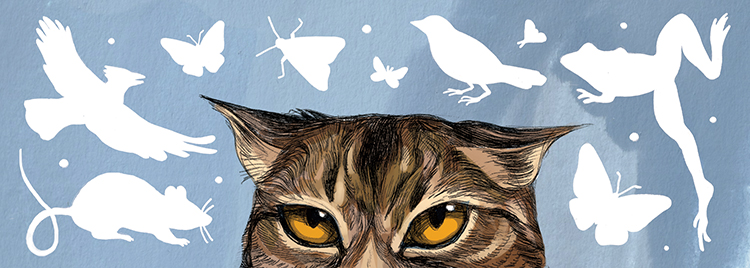 story by Bernard BrownThe birds and the butterflies get the majority of attention, and rightly so. You can’t ignore a scarlet cardinal or a swallowtail butterfly flashing its way across your garden. Our more brilliantly colored birds and insects have evolved to be seen. Almost as a rule, our native reptiles and amphibians have evolved to avoid notice. No one is dazzled by garter snakes or brown snakes, and the redback salamanders, however cute, will never take your breath away. Anything that we find beautiful about these creatures is subtle: elegant patterns in greens and earth tones, but nothing poster-worthy.
story by Bernard BrownThe birds and the butterflies get the majority of attention, and rightly so. You can’t ignore a scarlet cardinal or a swallowtail butterfly flashing its way across your garden. Our more brilliantly colored birds and insects have evolved to be seen. Almost as a rule, our native reptiles and amphibians have evolved to avoid notice. No one is dazzled by garter snakes or brown snakes, and the redback salamanders, however cute, will never take your breath away. Anything that we find beautiful about these creatures is subtle: elegant patterns in greens and earth tones, but nothing poster-worthy.Milk snakes are one exception to the rule. As these nonpoisonous snakes age, their pattern darkens, but they begin life with vivid patterns in crimson blotches edged with black on a cream background. Other regional varieties of milk snakes—they range west from Quebec to Montana and south to Ecuador—mimic brilliantly banded coral snakes their whole lives; ours get one, maybe two years of beauty.
I found one of those gems under a rock in the Wissahickon in 2005, and I’ve been obsessed with finding another ever since. I continue to fail. It’s not for lack of effort. Milk snakes generally do not wander in the open, so I have spent hour after hour peering under rocks in the wilder sections of Northwest Philadelphia. I’m very specific in this obsession: I’ve found milk snakes outside the city limits, but they don’t count. Lest I think they’re extinct here, or I wean myself off the obsession, friends continue to send me photos of Philadelphia milk snakes found under rock walls or freshly killed on the road. Staff at the Schuylkill Center for Environmental Education tell me they see milk snakes all the time (just not while I’m there).
Milk snakes got their name from their love of mice. Early livestock farmers in the Northeast suspected that the snakes were stealing milk from their cows, but they were actually drawn to barns by rodents. Philadelphia doesn’t have many barns anymore, and neither does it have many stretches of woods, fields, or any other habitat free of heavy motor vehicle traffic.
Cities can be tough environments for the non-humans. Studies of urban vertebrates have identified a few keys to succeeding: Don’t be picky about what you eat or where you live (think house sparrows); devote your reproductive energy to producing lots of babies, the better to rebound from the occasional near-extinction (think rats); and stay small to make better use of the small chunks of habitat available in a city (and to avoid the risk of crossing a street). Snakes have it a little harder than most other vertebrates—humans are particularly inclined to kill them—so they tend to do better by staying away from people.
As I’ve discovered, milk snakes are quite adept at staying out of sight. They are a little large for a city snake—averaging two and a half feet—and need just a little too much territory to survive in places other than the fringes of Philadelphia. The fields and forests we have out on the edges might be enough.
To be an urban naturalist is to accept the limitations of our depleted ecosystem, but maybe the milk snakes can hang on. Keep looking under rocks for the crimson-and-cream gems, and let me know if you find any.
Bernard Brown is an amateur field herper, bureaucrat and founder of the PB&J Campaign (pbjcampaign.org), a movement focused on the benefits of eating lower on the food chain. Read about his forays into the natural world at phillyherping.blogspot.com.




